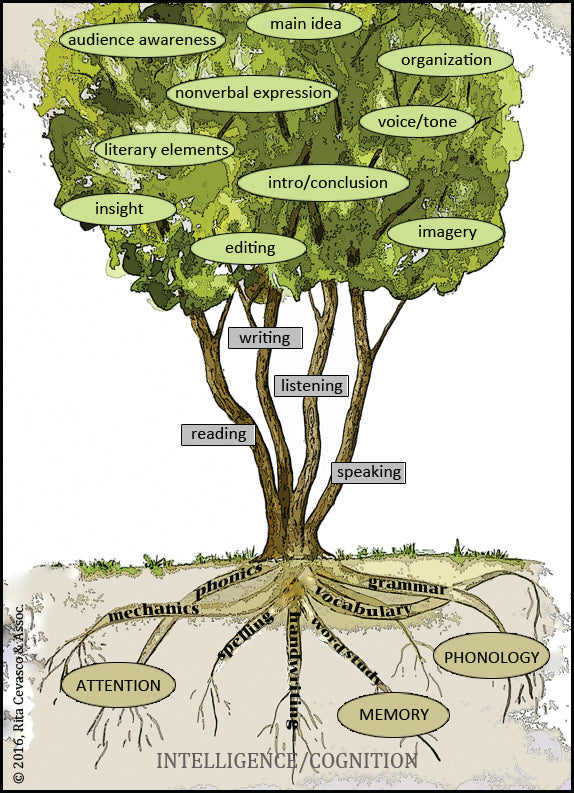In the Language Tree, the trunk of the tree represents our basic language system, broken into four parts: speaking, listening, reading and writing. Although language is one living system, it is like a multi-trunked tree—separate yet still a part of the whole. Likewise, language is understood and expressed in four modalities, with each mode intertwined, yet thriving on its own. As odd as it seems, the absence of one mode of language would certainly weaken the entire tree, yet would not destroy the other trunks.
A strong Language Tree has all modes of language thriving:
- Expressive skills (speaking or verbal production)
- Receptive skills (listening or verbal comprehension)
- Writing skills (encoding or text production)
- Reading skills (decoding or text comprehension)

Let's begin with Speaking and Listening, because we all begin life developing these skills. If you have experienced pregnancy (your own or in someone close to you), you already know that fetuses in utero react to sound—sometimes with a swift kick! Research suggests that fetuses even recognize their own mothers' voice, orienting differently than from other voices. I remember holding my own newborns and sensing the way they alerted or calmed to my voice as compared to other people's. As a fetus brain forms, it develops sensorineural functions that react and absorb both sound and visual information.
Our brains are language-ready for developing a spoken language, even before birth.
Infants also respond differently to their native speech sounds than to foreign ones, refining their auditory knowledge of speech even before producing sounds. Babies typically engage in cooing (around age 3 months) and babbling (from 4 to 12 months) without being taught, then follow developmental milestones of first words around 12 months and two-word sentence combinations around 18-20 months. We know babies need to feel love and safety, and to be nourished physically, in order to develop. But once those basic needs are met, babies thrive in their verbal development with little more than smiles from their parents. Babies also develop nonverbal rules of communication, such as turn-taking, sharing eye contact and using powerful cries of rage to get a fast response!
Vocabulary grows exponentially within the first two years of life. Again, given the proper stimulation and average physical and cognitive skills, all children learn to speak and to comprehend in their native tongue. There are regions of the brain within the left hemisphere that are innately specified for language development, so all our babies need is our undying love and attention to make the miracle of language expression and comprehension happen. Spoken language development is an "add water and stir" phenomenon. Albeit fraught with endless demands and repetition, parents find that actually "teaching" children language is one of the few easy jobs. Parents are required to engage constantly and answer many questions, but mostly we marvel over our young talkers.
For more on this visual metaphor depicting the components of literacy, download The Language Tree free download!
~ Rita
Note: Some children are born with specific language impairments that delay their progress in speaking or comprehension. When this occurs, parents should seek help in finding ways to maximize learning during the critical language development years. While many learners with language difficulties continue to progress in spite of their delays, there are important skills that need ongoing stimulation to improve language-based learning.


2 comments
this is not accurate enoh
this is not accurate enoh